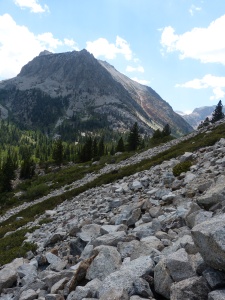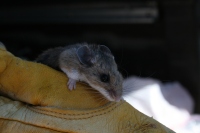by Deana Clifford
If I were to write an job advertisement, it might read something like this…
“Highly motivated individual needed to climb up and down unstable rocks all day at high elevation in an effort to study a very charismatic, but highly elusive small mammal.
Additional Qualifications: Must not be afraid of heights!”
What am I talking about? Studying pika of course!
Although American pikas (Ochotona princeps) may look a bit like a hamster or guinea pig, they’re actually most closely related to rabbits and hares. Pikas live in alpine terrain above the tree line. In California they are found at moderate to high elevations in the southern Cascades, Sierra Nevada and mountain ranges of the Great Basin. They live on rock-laden slopes called talus, and eat grasses, plants and wildflowers.
Pikas are charismatic. They are often seen or heard by hikers when they are defending their rocky territory. (Click here to watch video of a a pika calling.)
Habitat loss has caused the disappearance of some pika populations, but climate change is considered to be the primary threat to the long-term persistence of pika populations in California. Mining, grazing, disease and other factors may also impact pikas.
As part of my job as the Department of Fish and Game’s wildlife veterinarian for nongame species, I have been working with Dr. Janet Foley at UC Davis to study the health of pikas since 2010. Our goal is to find the best method to safely work with pikas and to determine which diseases could be a threat to pika populations by understanding what diseases are already present in pika populations.
In order to study the biology of pikas and evaluate threats to pika populations, we need to trap and examine individual pikas.
This is more challenging than one might think. Although it is relatively easy to see and hear pikas while on the talus, they are not particularly interested in entering a box trap for food. Also, since pikas live in remote areas, our teams often have to backpack into their habitat to study them.
Accomplished pika researcher Dr. Chris Ray at University of Colorado-Boulder has given us sage advice on how to lure pikas into our traps.
Although we were not successful at trapping pikas during our two short trips this summer, we were able to examine and sample other small mammal species that live in and near the pika’s habitat.
Determining which diseases are present in other small mammal species that border or overlap with pika populations will provide important information about the diseases pika may be exposed to.
Even though studying pika might be considered extreme field work, the effort is worthwhile because it gives us the chance to see this incredible animal and to gather information to inform future conservation efforts.
We will be back climbing the talus next summer!
This project has been one of the research endeavors fostered by the California Pika Consortium (CPC). The CPC is an interdisciplinary collaborative effort that fosters research, monitoring, education, conservation and adaptation planning for pikas and other high-elevation species.
To learn more about the work of the California Pika Consortium, the National Pika Consortium, and to find additional resources about pika conservation and biology click here.
If you are up for some extreme wildlife work, there are many citizen-science efforts to study pika populations, including: PikaNET, the ASC/I-naturalist Pika Project and Bristlecone Expeditions.
***Dr. Deana Clifford is the Department of Fish and Game’s wildlife veterinarian and epidemiologist for nongame, threatened and endangered species.




What I would have given to have a job like that right out of college!? Thanks for the citizen science links. Good luck with next years survey.